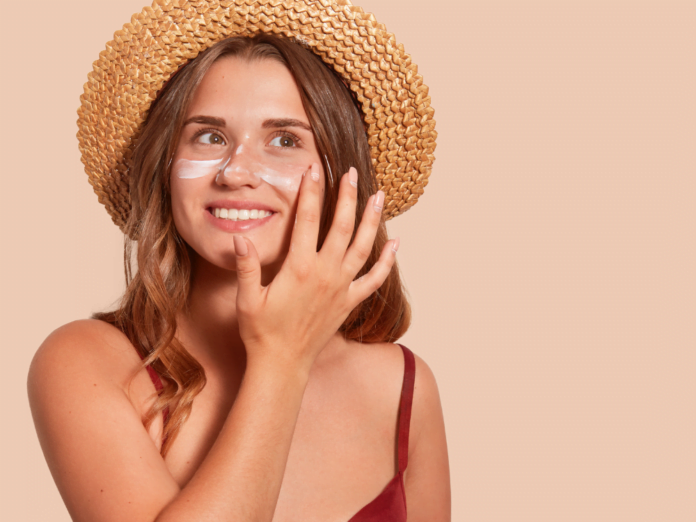The days are longer and warmer. As many of us are heading outside – either to work or play – it’s important to remember to practice skin safety. More skin cancers are diagnosed in the U.S. each year than all other cancers combined. May is recognized as Protect Your Skin Cancer Awareness Month, which encourages you to protect your skin and check for early signs of skin cancer.
Four Tips for Checking Your Skin
- Do a skin check. Examine your skin using full-length and hand-held mirrors. Skin cancer can develop even in areas not normally exposed to the sun. Be sure to check the bottoms of your hands and feet, armpits, and even personal areas for abnormalities.
This handy skin exam infographic from MHealthy is an at-a-glance reminder of key areas to check. Be diligent and if you see or feel any irregularities on your skin, have it checked immediately.
- Check regularly. Monthly self-exams are recommended. When found and treated early, skin cancer can usually be cured. Recommended skin cancer screenings are also covered under all U-M health plans (copays apply).
- Know your skin. Be aware of your normal pattern of moles, freckles, blemishes, and other marks on your skin so that you’ll notice any changes next time.
- Know your ABCDEs. Skin cancers can show up in many shapes and sizes. The American Cancer Society’s website includes possible signs, including an easy-to-remember ABCDE rule that helps you identify if your mole or mark might be skin cancer. If you have concerns about your skin, talk to your doctor.
Four Tips to Protect Your Skin
- Seek the shade. Between 10 a.m. and 4 p.m. is when UV light is strongest. If you’re planning to mow the lawn or head out for a walk, consider doing so before or after these hours.
- Cover up. When possible, wear a hat, long-sleeved shirt, pants, or a long skirt to cover the most skin. And don’t forget to wear sunglasses to protect your eyes.
The U-M vision plan covers sun tinting of plastic lenses, gradient tints, and glass gray #3 prescription sunglasses. Prescription sunglasses are also an eligible medical expense in U-M’s health care flexible spending account.
- Use sunscreen. Choose a broad-spectrum (UVA/UVB) sunscreen with an SPF of 15 or higher. Reapply sunscreen every two hours or immediately after swimming or excessive sweating.
If you are enrolled in U-M’s health care flexible spending account, over-the-counter sunscreen products with SPF 15 or higher are considered eligible medical expenses.
- Avoid tanning and UV tanning booths. Tanning beds that give out UVA and/or UVB rays have been linked with an increased risk of melanoma.
Protect the Skin From UV Radiation
Fortunately, there are measures to minimize the risks that come with sun exposure.
1. Block UV light with protective clothing and eyewear.
This includes wearing a hat (preferably wide-brimmed) as well as shade-protective clothing. This can partly shield the skin from the harmful effects of UV ray exposure. The American Academy of Ophthalmology notes that many forget to wear sunglasses that have a label that says it protects 99% of UV radiation for eye protection.
2. Stay in the shade, especially when UV radiation is most intense at midday between the hours of 10 am and 4 pm.
The sun can still damage the skin on cloudy days or in the winter, so year-round protection is important. Use caution when near reflective surfaces, like water, snow, and sand, which can reflect the damaging rays of the sun. This can increase the chance of sunburn, even in areas that appear to be shaded.
3. Choose the right sunscreen and apply it correctly.
The U.S. Food and Drug Administration’s regulations for sunscreen labeling recommend that the sunscreen have a sun protection factor (SPF) of at least 30, and it should protect against both UVA and UVB radiation. According to the National Council on Skin Cancer Prevention, most people apply only 25%–50% of the recommended amount of sunscreen. When out in the sun, apply at least one ounce (a palmful) of sunscreen every two hours. It should be applied more often when sweating or swimming, even if the sunscreen is waterproof.
In conclusion
safeguarding your skin year-round requires a consistent and proactive approach. By incorporating sun protection, moisturizing, and seasonal adjustments into your daily routine, you can ensure your skin remains healthy and radiant. Don’t forget the importance of a balanced diet, staying hydrated, and using quality skincare products. With these strategies in place, you’ll be well-equipped to protect your skin from the elements and maintain its youthful glow throughout the year. Remember, your skin is your largest organ, and taking care of it is an investment in your overall well-being.


